Recent Brit disks, part two
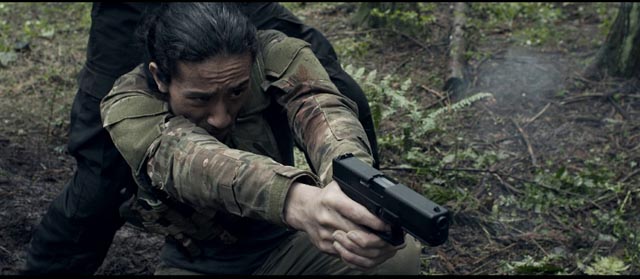
Re:Born (Shimomura Yûji, 2016)
To be honest, I’m not sure what to make of Shimomura Yûji’s Re:Born (2016), a return to the screen by Tak Sakaguchi after a brief hiatus following Sono Sion’s Why Don’t You Play in Hell? (2013). Tak made his debut in Ryûhei Kitamura’s Versus (2000), a movie whose sole purpose was non-stop action as a bunch of gangsters battle zombies in a Japanese forest connected to another world. This new film is a bit like that, but without the supernatural element. Tak, director Shimomura and fight coordinator Yoshitaka Inagawa developed a particular form of combat – zero-range combat – which involves getting up close with a variety of short blades to slice up your opponents, and cooked up a script to foreground a seemingly non-stop string of fight scenes.
After a murky and confusing prologue in which a unit of elite soldiers on a training exercise are killed off by a shadowy figure, we find former soldier Toshiro Kuroda running a small shop in a rural area, looking after an oddly solemn little girl named Sachi (Yura Kondo). He’s plagued by memories and dreams which he talks about with his therapist (Hitomi Hasebe), and has to make an effort to keep his violent tendencies in check. But then his former commander, Phantom (Akio Ôtsuka), shows up with a team of assassins to kill Kuroda, believing him to be the one who wiped out the unit. Turns out that was actually the Abyss Walker (Yoshitaka Inagawa).
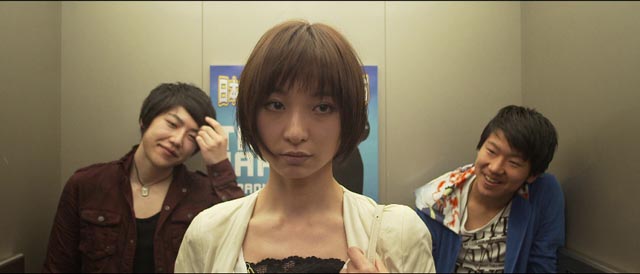
But none of this really matters because the whole point here is to see Tak slice his way through an endless supply of undifferentiated assailants. While the fight scenes are fast and visceral and occasionally inventive (there’s a great bit in a phone booth with Kuroda fighting off a female assassin), but without much of a narrative line or characters with more than one dimension, it remains pretty uninvolving and the repetition becomes exhausting.
Shot on video, Re:Born has a subdued colour palette to suit the grim business at hand. Eureka’s disk has no extras at all, which is a pity as it would have been interesting at least to hear the filmmakers talk about their intentions.
*
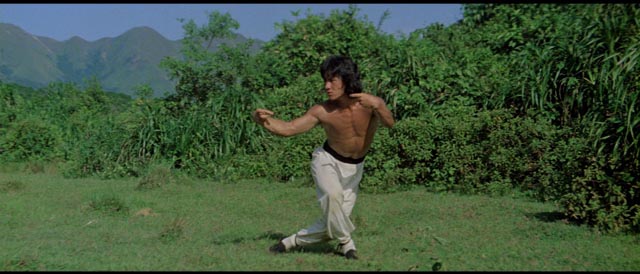
Drunken Master (Yuen Woo-ping, 1978)
More traditional, and considerably less grim, Eureka’s dual-format Masters of Cinema release of Drunken Master (1978) resurrects Jackie Chan’s break-out movie with a colourful 4K restoration. It’s always a surprise after decades of sub-par home video releases which testified to years of neglect to discover that someone somewhere has been preserving elements from Chinese and Hong Kong productions after all.
After years of being forced into inappropriate projects by producers who were looking for a replacement for Bruce Lee, Chan fortunately found himself in the hands of legendary martial arts choreographer and director Yuen Woo-ping and together they forged the screen persona which made the actor an international star. At the time, what they did may have seemed risky because they took revered historical and pop culture figure Wong Fei-hung and put him at the centre of an action comedy. Drunken Master has the young Fei-hung as an irresponsible, clownish guy who enjoys getting into fights and bringing shame on his father’s martial arts school. But even if he’s prone to breaking the rules, his heart’s in the right place. After trying to take advantage of an attractive girl in the market and getting himself soundly beaten by her mother (Linda Lin), who turns out to be his father’s sister, he defends a vendor from an obnoxious rich guy, whom he gives a severe beating. His victim’s father arrives at the school to complain and Fei-hung’s father decides that he needs some special discipline and training … so he arranges for his son to spend a year with the legendary Beggar So (Yuen Siu-tien).
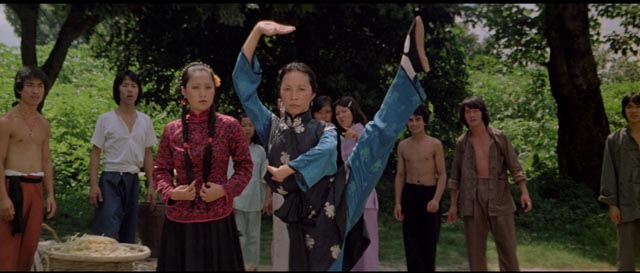
A hard task master, So is also a heavy drinker. In fact, his martial arts depend on him being drunk – both amplifying his considerable skills and disarming opponents who dismiss him as a drunkard. Subjected to grueling tasks intended to develop strength, dexterity and discipline, Fei-hung remains uncommitted, treating his training casually … until his inattentiveness results in So and himself getting beaten after he neglects to replenish the supply of wine. But even when he finally throws himself into learning “the eight drunken gods”, he balks at the eighth stance because it’s feminine (despite the fact he was earlier bested by his aunt).
Meanwhile an assassin has been commissioned to kill his father. The film’s loosely connected story threads inevitably lead to a climactic confrontation with the killer, a fight on a dusty road during which Fei-hung finally embraces everything So has taught him – including that eighth stance: Miss Ho, the drunken woman flaunting her body.
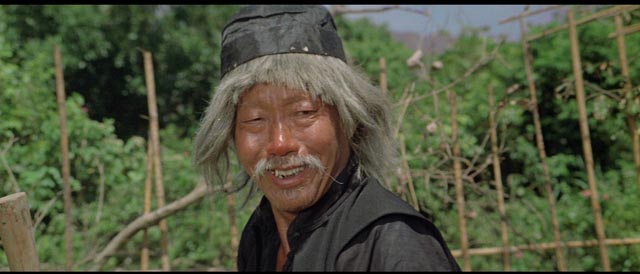
While much of Drunken Master is played for comedy, the martial arts choreography is taken seriously, providing a string of impressive fight scenes which have the appearance of being casually tossed off. This was the skill which Jackie Chan built on throughout his subsequent career – the ability to make the most complex (and often dangerous) physical action look effortless. The film was a huge financial success and Chan became a star.
Eureka’s Blu-ray has a bright and colourful image, which is an honest representation of the occasional roughness of the original film. There are multiple audio options, including an English dub and a Mandarin dub (made for a shorter version, with English filling in the gaps). I watched it with the original full Cantonese track which often sounds like the almost parodic audio which was much mocked back in the ’70s, with extremely loud effects for the blows in fight scenes (they sound very much like pieces of wood being hit against each other). There are also multiple subtitle options, different translations for each audio track.
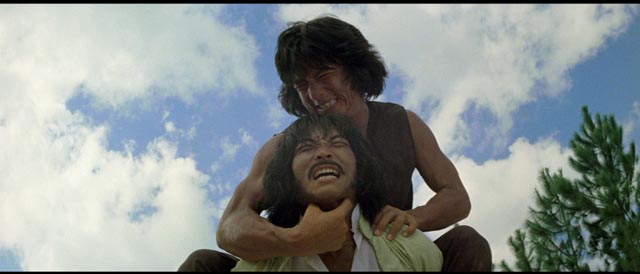
There’s a commentary track by Ric Meyers and Jeff Yang, a video interview with Chan, a piece with Asian film expert Tony Rayns, and an appreciation by director Gareth Evans. There’s also a brief deleted scene and a trailer, plus a booklet with an essay by Michael Brooke. Now if only Eureka would release a restored edition of Drunken Master 2 (1994), which contains some of Chan’s most spectacular fight choreography but has only been available on video in an English-dubbed, re-edited version courtesy of the odious Weinstein brothers.
*
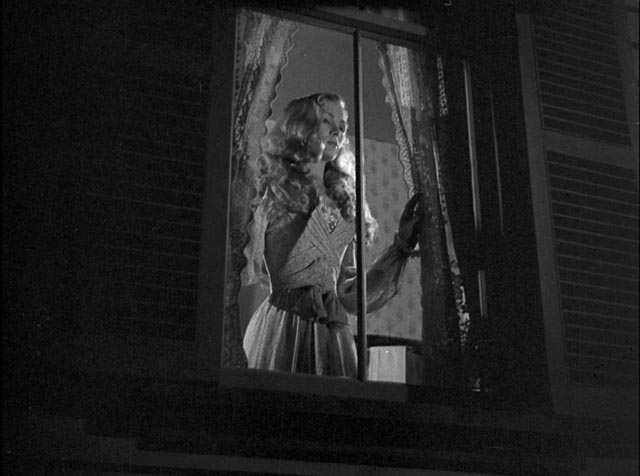
Ramrod (André De Toth, 1947)
Like many people, I first encountered André De Toth through House of Wax (1953), his gaudy 3D remake of Michael Curtiz’ Mystery of the Wax Museum (1933). In a way this was misleading, because House of Wax was De Toth’s sole foray into horror; he was better known as a prolific director of westerns and films noirs, with a style which was strong but not flamboyant – and an outlook inflected with cynicism about the human potential for doing good. His final film was the gritty and bitter World War Two adventure Play Dirty (1968), which ultimately spared none of its characters a grim fate.
Ramrod (1947) was the first of his westerns and he brings into it some of the dark themes prevalent at the time in film noir – something thrown into clear relief by the unexpected casting of Veronica Lake as Connie Dickason, a strong-willed woman in the mould of Barbara Stanwyck who moves from sympathetic heroine to destructive femme fatale as the story unfolds. (In fact it’s one of the earliest examples of what is known as western noir.)
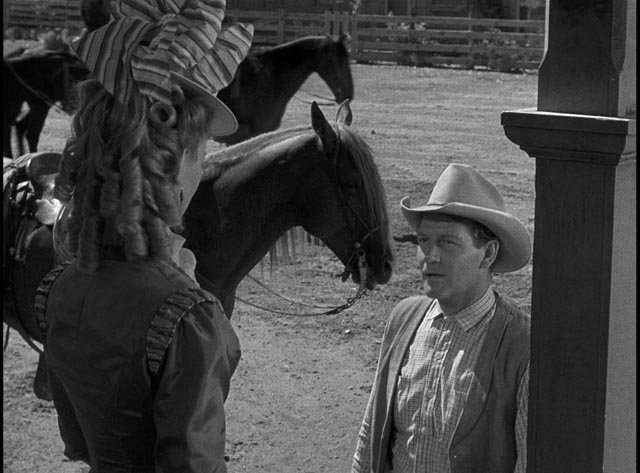
At the beginning of the film, Connie is defying her father Ben Dickason (Charles Ruggles) by insisting on marrying Walt Shipley (Ian MacDonald), who plans to introduce sheep into the valley in defiance of rancher Frank Ivey (Preston Foster). Her plans are also a finger in Frank’s eye as Ben has promised that Connie will marry the brutal rancher. In fact, her plan is obviously a way of defying both men who lay claim to possess her. Unfortunately, Walt is a weakling who is easily driven out of town by Frank and his men. But rather than reining in Connie, this just hardens her defiance. She takes over Walt’s abandoned ranch with the aid of Dave Nash (Joel McCrea), who has a personal dislike of Frank and his arrogant domination of the town and valley.
Frank’s men burn down Connie’s ranch house and beat one of her hands to death, but the local sheriff, Jim Crew (Donald Crisp), is powerless to deal with the escalating violence. Dave is a cautious man, loath to get drawn into open conflict with Frank, so Connie schemes to make things worse by having her men, led by the irresponsible Bill Schell (Don DeFore), stampede her herd off a cliff, claiming that Frank’s men were responsible.
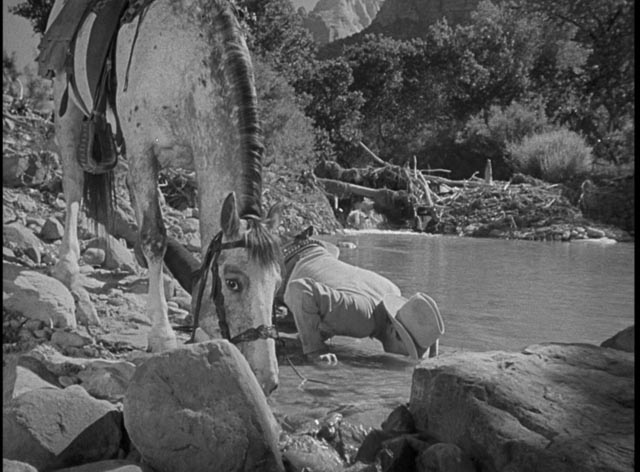
Connie’s hatred of her weak father and the sadistic Frank drives her to acts which lead to more violence and death, in a way becoming very much like Frank herself as she gains more power over the valley – power she wants Dave to share with her. But she misjudges him; he remains a decent man, even as he’s forced into a deadly confrontation with Frank. Although the story gives him a relatively happy ending – overcoming grief (and alcoholism) due to the death of his wife and child, he may have a fresh start with Rose Leland (Arleen Wheelan) – there are no untainted players in this conflict; he has unwittingly been fighting for someone who is as vicious as the opposition. Connie herself is left triumphant but alone.
Ramrod is reminiscent of the lean westerns made by Budd Boetticher in the ’50s with Randolph Scott, not to mention Anthony Mann’s The Furies (1950), in which Barbara Stanwyck plays another headstrong daughter asserting herself against a controlling father. The film is given unexpected edge by the casting of Lake and McCrea, who had costarred together six years earlier in Preston Sturges’ Sullivan’s Travels (1941), suggesting the possibility of a more conventional romantic relationship, an expectation shattered by Dave Nash’s damaged vulnerability and Connie Dickason’s increasing emotional hardness. Like Mann’s psychological westerns, Ramrod introduces darkness into a genre until then known mostly for a much more simplified moral schema.
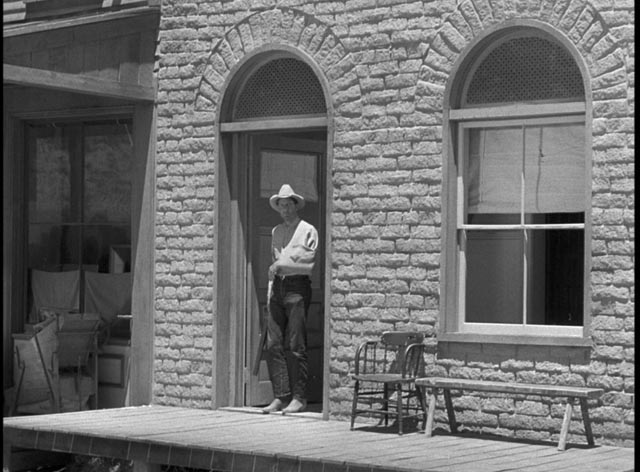
In addition to a pleasingly film-like image, Arrow’s Blu-ray includes some substantial extras – two audio interviews with de Toth (with documentary filmmaker Patrick Francis [1:34:45] and, from 1994, at the National Film Theatre [47:30]), a commentary from film scholar Adrian Martin, and a video appreciation from genre film expert Peter Stanfield (who inexcusably identifies the actor playing villain Frank Ivey as Robert Preston rather than Preston Foster, an error compounded by the inclusion of a head shot of Robert Preston in the featurette).
*
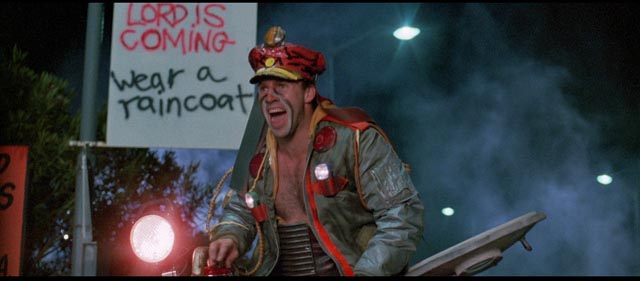
Dead-End Drive-In (Brian Trenchard-Smith, 1986)
Born in England and transplanted to Australia, Brian Trenchard-Smith made several key Ozploitation features, though he may go down in cinema history for giving Nicole Kidman her first lead role (at age sixteen) – in BMX Bandits (1983), a kids’ film built around the BMX bike craze. He introduced martial arts into Australian movies with The Man from Hong Kong (1975); tried to wed his love of movie stunts and rock music in Stunt Rock (1979); and made a Vietnam war movie (The Siege of Firebase Gloria [1989]), not to mention Leprechaun 3 (1995) and Leprechaun 4: In Space (1996). Working with low budgets and a complete lack of pretension, Trenchard-Smith is an unabashed exploitation filmmaker. (He’s also one of the most knowledgeable and engaging commenters on Trailers From Hell, each commentary a small information-packed lesson in film history.)
Although it’s always risky to say that someone’s earlier work is their best, in Trenchard-Smith’s case for me he peaked in the early 1980s (though I have to admit I haven’t seen much of his later work) with a pair of imaginative dystopian political fantasies. Turkey Shoot (1982) is an update of The Most Dangerous Game in which rich people favoured by a fascist government pay for the privilege of hunting political prisoners to the death. Conceived on a grander scale, Trenchard-Smith was forced to cut a lot out when the budget was reduced by half just before filming started, but he still managed to make a gritty, violent action film which expresses contempt for the direction western democracies have been heading over the past four decades.
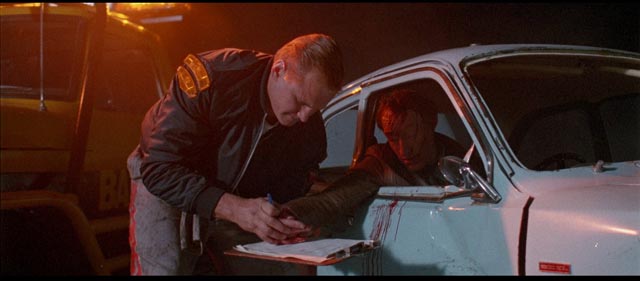
Those politics also inform what for me is his best film, Dead-End Drive-In (1986), set in a similar world to George Miller’s original Mad Max (1979), an anarchic landscape characterized by highway mayhem and contempt for authority. But while Miller’s film takes the side of the outnumbered remaining authorities, Trenchard-Smith deals with the people caught between the violent outlaws and the repressive government striving to retain its control.
Crabs (Ned Manning) wants to join his tow-truck driving brother in the high-stakes business of claiming salvage from the frequent deadly multi-car crashes on the streets of a city which looks like an industrial wasteland. But when he gets a chance to ride along one night, he is sickened by the sight of crushed bodies and the conflicts among salvage drivers, the police and emergency medical workers trying to make the most out of the wreckage.
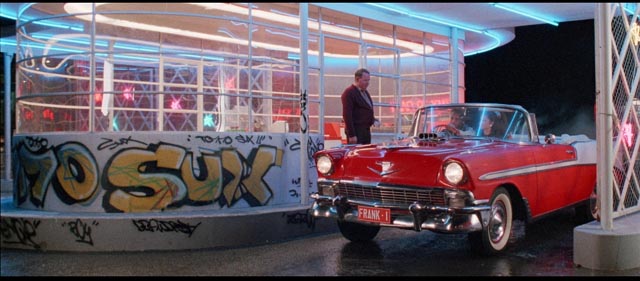
One evening, Crabs borrows his brother’s prize Chevy without permission to take his girlfriend Carmen (Natalie McCurry) to the drive-in. He makes the fatal mistake of claiming that they’re both unemployed in order to get discount tickets. As that night’s feature plays on-screen (Trenchard-Smith’s The Man from Hong Kong), Crabs and Carmen make out on the back seat … interrupted when someone steals a couple of the car’s wheels. Crabs takes off after them and discovers the thieves are cops in a white van.
When Crabs goes to the drive-in manager, Thompson (Peter Whitford), he gets no satisfaction. He’s told where the amenities are and that he should go back to his car and get some sleep. It only dawns on Crabs slowly the next morning, when he wakes and finds others also stuck there, that he and Carmen are actually now imprisoned. They were singled out because of his claim of unemployment – that makes them undesirables and the government has created this network of “voluntary prisons” (you drive yourself in and can’t leave) for people like them.
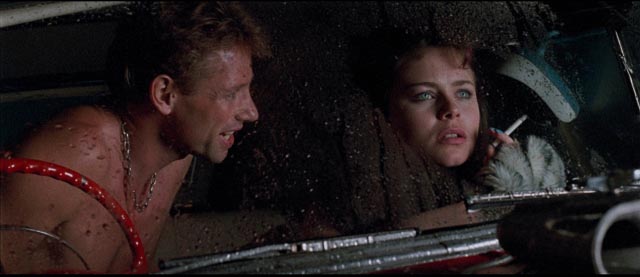
Crabs has to navigate the prison’s social hierarchy, standing his ground against gangs, helping Thompson out with chores in hopes of finding some way to get out, and dealing with Carmen’s quick acquiescence to their captivity – she makes friends and doesn’t believe the world outside is any better than where they now find themselves. The stakes are upped when the authorities begin trucking in Asian refugees and immigrants, triggering a whole new level of tribalism reflecting racism and calls for a “White Australia”. Crabs further isolates himself by defending the newcomers.
Not identifying himself with his fellow prisoners, Crabs makes a break for it, resulting in a violent chase around the drive-in which pretty much destroys the impromptu community with gunfire, explosions and vehicular mayhem (Trenchard-Smith doesn’t dwell on it, but there’s little doubt that Crabs’ actions result in quite a lot of deaths) before he makes his spectacular escape by launching a three-ton tow truck up a ramp, through the drive-in’s neon sign, landing hard on the road beyond and heading out into a wasteland which might be the location for the opening chase in Mad Max.
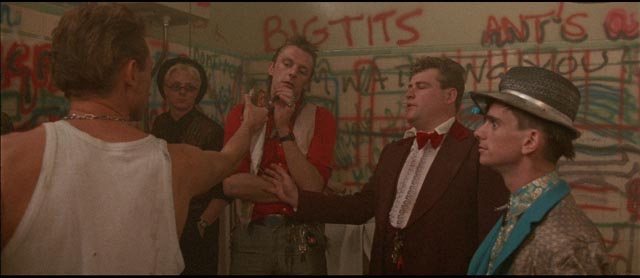
Dead-End Drive-In is pulp politics steeped in punk design and disgust for a conservative culture which privileges the rich and holds the young and immigrants in contempt. Colourful and energetic, the film finds unapologetic pleasure in anarchy.
Arrow’s Blu-ray is a major improvement over the old Anchor Bay DVD from 2003, with a vibrant and detailed image and richer sound. There’s a commentary by Trenchard-Smith (not sure if that’s the same as the one from Anchor Bay) and, making it a must-have package, a pair of short films by the director – The Stuntmen (1973, 48:47), a television documentary in which interviews with big names in the business (Grant Page, Bob Woodham, Graham Mathrick, Roger Ward and others) are interspersed with sequences showing how various dangerous stunts are set up (complete with errors and injuries); and Hospitals Don’t Burn Down! (1978, 24:11), a public safety film sponsored by the Department of Veteran’s Affairs, in which a carelessly discarded cigarette triggers a fire which staff and patients are unprepared for, resulting in some quite graphic and grisly deaths. Dubbed Towering Infirmary, it’s a convincingly horrifying disaster mini-epic representing some of Trenchard-Smith’s best work. There’s also an image and text gallery focusing on the graffiti art of Vladimir Cherepanoff which decorates the film’s drive-in.
Comments